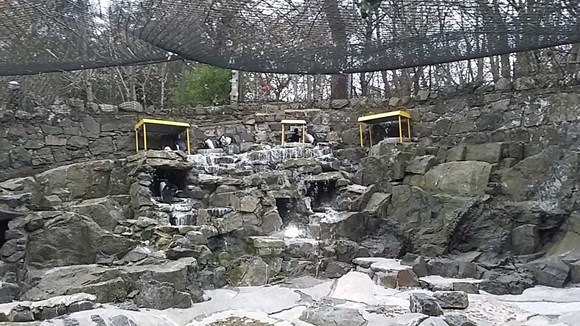Breeding season with the Rockhoppers
28/04/2016 in Edinburgh Zoo
As winter comes to an end and we welcome spring, everything changes at Penguins Rock, and for the small Northern rockhoppers it marks the start of breeding season.
In late February, 20 of our 22 rockhoppers moved from Penguins Rock to their breeding enclosure further up the hill, not too far from the Gelada baboons. This enclosure, with its rock face design, provides multiple levels for the birds to set up their nests. In the wild, Northern rockhopper penguins choose cliff habitats in which to breed, such as those found on the Island of Tristan da Cunha, so this enclosure is well suited to their needs.

Northern rockhopper penguins are fairly monogamous but have been known to change their partner if their usual companion is unwell or unsuccessful. In comparison with Gentoo penguins, we do see the pairs spending more time together outwith the breeding season. Courtship behaviour is also slightly different, with the males making a good start on the nest before the female arrives. We would also expect to see lots of vocalisations between each pair, as well as a mutual head shaking movement.
Once up at the breeding enclosure these crested penguins are provided with small stones and sticks so they can build their nests on the various mesh platforms. This has been an extra special year for some of our youngest females, as we have seen them lay their first ever eggs. Although each female is capable of laying two eggs, a few have laid just the one. This is quite common for first time layers, as well as for older females as they come to the end of their laying life. When a female lays two eggs, usually the second egg is larger than the first and, as a result, receives better care. The first egg can often be kicked out of the nest and, in the wild, may even be used as a predator distraction. With this in mind, we remove the smaller eggs from the nest site and place them in an incubator.
In total there have been ten eggs laid so far this year. It is too early to say if these eggs are fertile but we are hopeful of success. Incubation is usually around 33-35 days, so any viable eggs would be expected to hatch around the end of April and into the beginning of May. From a conservation stand point, it is increasingly important that we see breeding success amongst captive populations of rockhoppers as wild populations continuing to decline. Some islands, like Gough Island, have seen population loss of up to 90%, leading the species to be classified as Endangered on the IUCN Red List. Click here to find out how RZSS is working with RSPB and the British Antarctic Survey on Project Pinnamin, to help conserve wild northern rockhopper penguins.
Stay tuned for more updates as the breeding season progresses!
Dawn Nicoll
Senior Animal Keeper, RZSS Edinburgh Zoo
Featured Content
Featured Articles

An update from the Budongo Forest
19/04/2024 in Conservation

Edinburgh Zoo named best zoo in Scotland
15/04/2024 in Edinburgh Zoo
Latest News
-
News

07/03/2024
Edinburgh children paint pretty pebbles for penguins
Edinburgh Zoo’s gentoo penguins have been given painted pebbles to celebrate the start of penguin breeding season.
-
Blog

20/01/2024
Penguin Awareness Day 2024
Edinburgh Zoo is home to the largest outdoor penguin pool in Europe, with three different species and over 100 individuals. This penguin awareness day get to know some of the famous faces in the colony who you can also watch live on our penguin cam.
-
Blog

24/10/2023
Caring for penguins at Edinburgh Zoo and beyond
Through their expertise and research, our vet team provide the highest standard of care for our animals and make important contributions to understanding how we can better protect wildlife. Dr. Stephanie Mota shares more about their recent research on a fungal disease which affects penguins.
-
News

21/08/2023
Sir Nils Olav promoted at Edinburgh Zoo
His Majesty the King’s Guard Band and Drill Team of Norway, who are performing at The Royal Edinburgh Military Tattoo this year, visited the Royal Zoological Society of Scotland’s (RZSS) Edinburgh Zoo to promote and bestow a unique honour upon the resident king penguin, Sir Nils Olav.

























Follow EZ